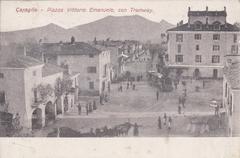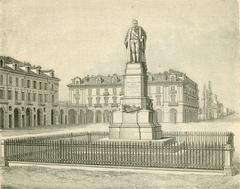Complete Guide to Visiting Viadotto Soleri in Cuneo, Italy
Publication Date: 01/08/2024
Introduction
Viadotto Soleri, an architectural and historical landmark in Cuneo, Italy, stands as a testament to the city’s rich heritage and engineering prowess. Named after Marcello Soleri, a significant political figure and lawyer, the viaduct encapsulates over a century of historical and cultural evolution. Its construction began in the turbulent early 20th century, reflecting the innovative spirit and resilience of the era (source). The bridge not only facilitated transportation and connectivity but also became a symbol of progress and modernity for Cuneo. From its role during World War II to its importance in post-war reconstruction, Viadotto Soleri has been pivotal in shaping the city’s growth. Today, it continues to stand as a key infrastructural element and a popular tourist attraction, offering visitors a glimpse into the past while providing practical connectivity in the present. This comprehensive guide aims to provide all necessary information for visitors, including historical context, visiting hours, ticket information, and nearby attractions, ensuring a memorable experience at this iconic site.
Table of Contents
History of Viadotto Soleri
Origins and Construction
The Viadotto Soleri, also known as the Soleri Viaduct, is a significant architectural and infrastructural landmark in Cuneo, Italy. Named after Marcello Soleri, a prominent lawyer and political figure from Cuneo, the viaduct stands as a testament to his contributions to the city and the nation. Soleri, born in 1882, was deeply involved in Italian politics, particularly during the tumultuous years between the two World Wars. His influence extended beyond politics into urban development, which is evident in the naming of the viaduct after him (source).
Political Context
Marcello Soleri’s political career was marked by significant events that shaped Italy’s history. He served as Mayor of Cuneo at the young age of 30 and was later elected to the Chamber of Deputies in 1913. During his tenure, he supported the policies of Giovanni Giolitti and played a crucial role in urban planning and development in Cuneo. One of his notable achievements was signing an agreement with Italy’s state-owned railroad system to build a new railway station on the plateau, which laid the groundwork for future infrastructural developments, including the Viadotto Soleri (source).
Architectural Significance
The Viadotto Soleri is not just a bridge; it is a symbol of Cuneo’s resilience and progress. The viaduct serves as a critical connection between different parts of the city, facilitating both road and rail traffic. Its construction was a significant engineering feat, designed to accommodate the growing transportation needs of the city. The viaduct’s design incorporates both functionality and aesthetic appeal, making it a landmark that residents and visitors alike can appreciate.
Role in World War II
During World War II, Cuneo, like many other Italian cities, faced significant challenges. Marcello Soleri, who had opposed Italy’s entrance into World War I but later volunteered to serve on the front lines, continued to play a vital role in the city’s political landscape. After Mussolini’s overthrow on July 25, 1943, Soleri addressed the people of Cuneo from his lawyer’s office at 2, Piazza Galimberti, urging them to remain calm during this turbulent period. This moment underscored the importance of maintaining critical infrastructure, such as the Viadotto Soleri, to ensure the city’s stability and connectivity (source).
Post-War Developments
After the war, Cuneo underwent significant reconstruction and development. The Viadotto Soleri played a crucial role in this process, serving as a vital link for transportation and commerce. The viaduct’s importance was further highlighted when the town paid tribute to Marcello Soleri with a solemn funeral service upon his death in 1945. In recognition of his contributions, several important buildings and streets in Cuneo were named after him, including the Viadotto Soleri, the railroad and road bridge leading to Corso Soleri, and the central Piazza Galimberti (source).
Modern-Day Significance
Today, the Viadotto Soleri remains a key infrastructural element in Cuneo. It not only facilitates transportation but also stands as a historical monument, reminding residents and visitors of Marcello Soleri’s legacy. The viaduct’s strategic location and design continue to support the city’s growth and development, making it an essential part of Cuneo’s urban landscape.
Visitor Information
Visiting Hours and Tickets
- Visiting Hours: The Viadotto Soleri is accessible to the public 24/7. There are no specific visiting hours, making it convenient for any travel itinerary.
- Tickets: There is no entrance fee to visit the viaduct. However, guided tours may be available through local tour operators for a fee.
Accessibility
The viaduct is easily accessible from various parts of the city. It connects to Corso Soleri, a major avenue lined with trees and home to the lower secondary school “Istituto Comprensivo di Cuneo” (source).
Photography
The viaduct offers excellent opportunities for photography, especially during sunrise and sunset when the lighting enhances its architectural features.
Nearby Attractions
While in the area, explore other nearby attractions such as Piazza Galimberti, which is central to Cuneo’s historical and cultural life.
FAQ
-
What are the visiting hours for Viadotto Soleri?
- The viaduct is accessible 24/7, making it convenient for visits at any time of day.
-
How much are tickets to Viadotto Soleri?
- There is no entrance fee to visit the viaduct. Guided tours may be available for a fee.
-
Are there any guided tours available?
- Yes, local tour operators may offer guided tours that provide more in-depth historical and architectural insights.
-
What are some good spots for photography?
- The viaduct itself is a great spot, especially during sunrise and sunset. Piazza Galimberti nearby also offers picturesque views.
Conclusion
In conclusion, Viadotto Soleri is more than just a bridge; it is a monument to Cuneo’s historical resilience and architectural innovation. Named after Marcello Soleri, whose contributions to Italian politics and urban development were significant, the viaduct has played crucial roles from its initial construction through the challenges of World War II and into the modern era. Its accessibility, aesthetic appeal, and historical significance make it a must-visit landmark for anyone exploring Cuneo. Visitors can enjoy the viaduct at any time, with no entrance fee, making it a convenient and enriching part of any travel itinerary. Nearby attractions, such as Piazza Galimberti and the Maritime Alps, add further depth to the visitor experience, while local culinary delights offer a taste of Piedmont’s rich gastronomic heritage. For those interested in delving deeper into the history and architecture of Viadotto Soleri, guided tours are available, providing insightful commentary and enhancing the overall visit. Whether you’re a history enthusiast, a photography lover, or simply a traveler looking to explore the beauty of Italy, Viadotto Soleri promises a memorable and enlightening experience. For more information and updates, visitors are encouraged to download the Audiala app and follow related social media channels (source).
References
- Il Terzocchio di Cuneo (n.d.). Viadotto Soleri. Retrieved from http://www.ilterzocchio.it/pagina_en.php?idPagina=2
- Wikipedia contributors. (n.d.). Viadotto Soleri. In Wikipedia, The Free Encyclopedia. Retrieved from https://it.wikipedia.org/wiki/Viadotto_Soleri
- MominItaly (n.d.). Italy in August. Retrieved from https://mominitaly.com/italy-in-august/
- TrekZone (n.d.). Viadotto Soleri, Cuneo. Retrieved from https://trek.zone/en/italy/places/188052/viadotto-soleri-cuneo

